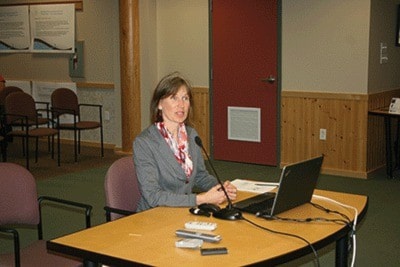“We’re here to celebrate five years of Carbon Neutral Kootenays,” said Patricia Dehnel to open an Earth Day delivery to Castlegar City Council on April 21, “a wonderful project of collaboration with the local government to be more energy efficient in their corporate emissions, corporate responsibilities.”
Dehnel narrated a visual presentation loaded with facts and stats relating to the program, said to be unique in B.C., encompassing three regional districts and the Columbia Basin Trust. The goal (being successfully reached, according to Dehnel’s presentation) has been to reduce the carbon footprint created by the combined administrative bodies which count a large number of buildings and vehicles among their assets.
One striking statistic revealed in the council session was the fact that an overall 10 per cent drop in regional greenhouse gas output had been achieved through the program.
Corporate and community considerations have been central components in the effort to date, and Dehnel pointed to good responses from both sectors.
The initiative can trace its roots back to 2008 and a document known as the Climate Action Charter.
“Local governments were asked to voluntarily sign an agreement,” explained Dehnel, “and if they did so they agreed, among other things, to being carbon neutral in respect to their corporate operations by 2012. That has since been reduced to just working toward being carbon neutral… but that’s how it all started.”
Dehnel related how the 31 local governments in this part of the province, thought, “Oh my goodness, what are we going to do now that we’ve signed this? The three regional districts (RDCK, RDKB and RDEK) and the Columbia Basin Trust came together for an amazing, collaborative, first and only initiative in B.C. to fund and support the 31 local governments to work toward being carbon neutral.”
Affected under the plan, said Dehnel, are 400 buildings, 1,000 vehicles and 20,000 tonnes of emissions in the project area… $11 million spent annually on energy.”
Dehnel described the five years spent on Carbon Neutral Kootenays, starting in 2009 as “amazing,” and mentioned that 200 person-days of education, including members of Castlegar City Council had also been completed as part of the program.
“We moved along, we went into planning,” said Dehnel, “…provided templates, identified opportunities moving into more action.” As an example of that action Dehnel mentioned the successful Kootenay Energy Diet program, which, in Castlegar, had included 91 local residences.
In terms of actual carbon neutrality, Dehnel indicated that support and participation was widespread, although it was Kaslo and New Denver which had committed, “as those two local governments did choose to be carbon neutral for this year, and they’ll be purchasing offsets.”
Wrapping up a thorough presentation, the Community Energy Association’s West Kootenay Project Liaison regarding Carbon Neutral Kootenays made herself available for council members’ questions, of which there was none.
Councillor Kevin Chernoff did have a positive comment on the presentation, mentioning the learning curve that comes with this kind of program, and stating, “It’s something in the back of the City’s mind whenever we do our projects…to keep them as green as possible, a lot of that is through the guidance of your group. It’s been a really good partnership.”
